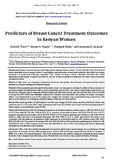| dc.description.abstract | Background: Breast cancer is the most prevalent cancer among Kenyan women. Worldwide data show that diverse factors including socio-economic status, co-morbidities, and expression of hormonal receptors, have effect on disease recurrence or metastasis following treatment. Most studies on breast cancer treatment outcomes have been undertaken in developed countries, and there is scarcity of data on predictive indicators of breast cancer treatment outcomes in Africa.
Objective: This study was designed to determine the factors that predict the treatment outcomes in breast cancer patients in a Kenyan teaching and referral hospital.
Methods: This hospital based retrospective descriptive study was designed to evaluate the effect of the occurrence of estrogen receptor, progesterone receptor, human epidermal growth factor and cancer stage among other factors on the outcome of breast cancer treatment. Patients diagnosed with breast cancer and who had their first visit at the KNH in the period 2007-2008 were identified. Quantitative variables were described with medians or means. Association effects were determined by use of Chi-square test. Categorical variables were summarized using proportions. The time to event analysis was estimated using the Kaplan–Meier product limit method.
Results: The mean age of the 219 participants was 46.5 years (range 23 to 92 years), majority (36.1%) of whom were aged between 41 to 50 years. Most study participants had stage 2B (21.9%) cancer type, and the histological grade 3 breast cancer was predominant type (50.2%).
Nearly half of the patients (46.1%) developed metastases. In bivariate analyses, cancer stage 2A (OR 0.29, 95% CI 0.12 to 0.77) and stage 2B (OR 0.41, 95% CI 0.21- 0.77), presence of estrogen receptors (OR 0.24, 95% CI 0.12 to 0.77), presence of progesterone receptor (OR 0.26, 95% CI 0.09 to 0.72), human epidermal growth factors (OR 0.05, 95% CI 0.003 to 0.84), and those on hormonal treatment (OR 0.34, 95% CI 0.19 to 0.62) were factors less likely to be associated with development of metastasis after treatment. In multivariate analysis, HIV positive status (OR 0.004, 95% CI 0.002 to 0.75), presence of estrogen (OR 0.23, 95% CI 0.08 to 0.64) and human epidermal growth factors (OR 2.53, 95% CI 1.64 to 3.91) receptors and obesity (OR 2.53, 95% CI 1.64 to 3.91) were independent factors influencing development of metastasis after treatment.
Conclusion: This study showed that development of metastasis after breast cancer therapy has associations with the expression of estrogen receptor (ER), progesterone receptor (PR) and human epidermal growth factor receptor -2 (HER-2) as well as the stage of diagnosis. This study demonstrates the need for enhanced screening for breast cancer to improve early diagnosis and the testing of ER, PR and HER-2 are crucial as they predict outcomes of therapy. | en_US |

